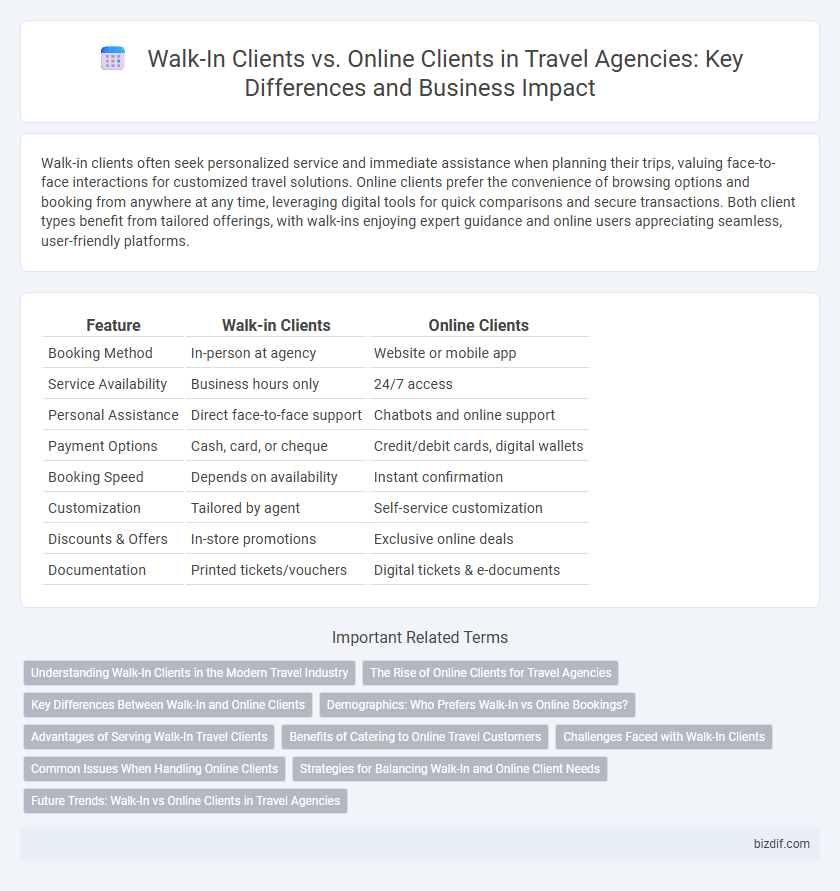Walk-in clients often seek personalized service and immediate assistance when planning their trips, valuing face-to-face interactions for customized travel solutions. Online clients prefer the convenience of browsing options and booking from anywhere at any time, leveraging digital tools for quick comparisons and secure transactions. Both client types benefit from tailored offerings, with walk-ins enjoying expert guidance and online users appreciating seamless, user-friendly platforms.
Table of Comparison
| Feature | Walk-in Clients | Online Clients |
|---|---|---|
| Booking Method | In-person at agency | Website or mobile app |
| Service Availability | Business hours only | 24/7 access |
| Personal Assistance | Direct face-to-face support | Chatbots and online support |
| Payment Options | Cash, card, or cheque | Credit/debit cards, digital wallets |
| Booking Speed | Depends on availability | Instant confirmation |
| Customization | Tailored by agent | Self-service customization |
| Discounts & Offers | In-store promotions | Exclusive online deals |
| Documentation | Printed tickets/vouchers | Digital tickets & e-documents |
Understanding Walk-In Clients in the Modern Travel Industry
Walk-in clients in the modern travel industry prioritize personalized service and immediate assistance, fueling local travel agencies' demand for face-to-face interactions. These clients often seek tailored recommendations and last-minute bookings, valuing the trust and expertise offered by on-site travel consultants. Understanding walk-in client behavior helps agencies optimize in-store experiences and complement digital strategies for comprehensive customer engagement.
The Rise of Online Clients for Travel Agencies
The rise of online clients has transformed travel agencies, with over 70% of bookings now made through digital platforms, offering convenience and 24/7 access to travel options. Online clients demand personalized itineraries powered by AI and extensive user reviews, creating a shift from traditional walk-in consultations. Travel agencies investing in robust online systems report a 30% increase in client engagement and streamlined booking processes.
Key Differences Between Walk-In and Online Clients
Walk-in clients prefer face-to-face interactions, seeking personalized service and immediate assistance, while online clients value convenience and 24/7 accessibility through digital platforms. Walk-in clients often require physical brochures and in-person consultations, whereas online clients rely heavily on user-friendly websites, chat support, and instant booking capabilities. Travel agencies must tailor marketing strategies and customer service approaches to accommodate these distinct preferences and enhance overall client satisfaction.
Demographics: Who Prefers Walk-In vs Online Bookings?
Walk-in clients are often older adults, typically aged 50 and above, who prefer face-to-face interaction and personalized service when booking travel. Online clients tend to be younger travelers, primarily between 18 and 35 years old, favoring convenience and instant access to deals via digital platforms. Urban dwellers with higher digital literacy predominantly choose online bookings, while rural or less tech-savvy populations are more inclined towards walk-in services.
Advantages of Serving Walk-In Travel Clients
Serving walk-in travel clients offers personalized, face-to-face interaction that enhances trust and immediate problem resolution. Walk-in customers benefit from on-the-spot tailored travel advice and the ability to ask detailed questions, leading to more confident booking decisions. This direct engagement often results in higher customer satisfaction and repeat visits, strengthening client loyalty for the travel agency.
Benefits of Catering to Online Travel Customers
Catering to online travel customers significantly expands reach by enabling 24/7 booking access and personalized recommendations through AI-driven platforms. Online clients benefit from instant price comparisons, exclusive discounts, and seamless itinerary management, enhancing overall customer satisfaction. Travel agencies can leverage data analytics from online interactions to optimize marketing strategies and tailor offers, increasing conversion rates and fostering customer loyalty.
Challenges Faced with Walk-In Clients
Walk-in clients present unique challenges for travel agencies due to unpredictable arrival times and varying levels of preparedness, which complicates scheduling and resource allocation. Unlike online clients who often book with pre-set selections and payments, walk-in customers require personalized, on-the-spot assistance, increasing demand on staff expertise and time. Managing walk-ins also poses difficulties in maintaining social distancing protocols and ensuring efficient service flow during peak travel planning seasons.
Common Issues When Handling Online Clients
Online clients often face challenges such as unclear communication, difficulty verifying service details, and delayed responses from travel agents. Booking errors and payment security concerns are common issues that affect their overall experience. Efficient customer support and transparent information are essential to address these problems and improve satisfaction.
Strategies for Balancing Walk-In and Online Client Needs
Travel agencies implement tailored strategies to balance walk-in and online client needs by integrating personalized in-store consultations with seamless digital booking platforms, ensuring convenience and human interaction. Leveraging customer relationship management (CRM) systems enables effective tracking of client preferences, facilitating customized offers that appeal to both demographics. Emphasizing flexible communication channels, such as live chat and on-site assistance, enhances client satisfaction and operational efficiency across touchpoints.
Future Trends: Walk-In vs Online Clients in Travel Agencies
Travel agencies are experiencing a significant shift as online clients increasingly prefer personalized digital experiences while walk-in clients seek expert face-to-face consultations. Data indicates a growing trend toward mobile bookings and AI-powered virtual assistants, enhancing convenience and immediacy for online users. Future strategies will likely integrate hybrid models combining digital tools with in-person service to optimize client engagement and satisfaction.
Walk-in clients vs Online clients Infographic

 bizdif.com
bizdif.com